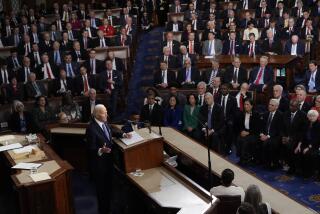Five things we learned from the January jobs report about the economy Trump inherits
Surprisingly robust job gains last month demonstrated that President Trump took office amid a solid labor market that might have been boosted by optimism about his promises of pro-business policies.
But the Labor Department data released Friday also indicated more work is needed in the recovery from the Great Recession.
The report showed that stubbornly slow wage growth remains a challenge for workers, and a potential caution flag for Federal Reserve officials as they consider if the economy is strong enough to handle additional increases in a key interest rate.
The topline numbers, however, were excellent, economists said.
The U.S. added 227,000 net new jobs, the most since September. And although the unemployment rate ticked up to a still-low 4.8%, that was largely because more people came off the sidelines to look for jobs.
“He inherited a generally healthy job market that still shows some scars from the recession and financial crisis,” said Mark Hamrick, senior economic analyst at financial information website Bankrate.com, of Trump.
“It might take a little examination to see those scars, but those wounds are partly what helped to propel him to office,” Hamrick said.
Here are five things we learned from the January report.
Trump gets a much better jobs landscape than Obama did
Before a White House meeting with business executives, Trump said he was “very happy” with the job growth.
“There’s a great spirit in the country right now,” Trump said.
“I think it’s going to continue big-league,” he said. “We’re bringing back jobs. We’re bringing down your taxes. We’re getting rid of your regulations. And I think it’s going to be some really very exciting times ahead.”
The January jobs report was the final one for the Obama administration. The data were collected in the middle of last month before Trump took office.
But job growth might have been influenced by increased business and consumer confidence after Trump’s election, Hamrick said.
“On the one hand, you say businesses might not be willing to add workers until they see a rise in demand,” he said. “But on the other hand they may be making some strategic decisions where they anticipate demand.”
When Obama took office in January 2009, the economy had shed 791,000 net jobs that month alone. The unemployment rate had jumped to 7.8% on its way to a 26-year high of 10% by the fall of 2009.
Job growth returned for good the following year as the unemployment rate slowly declined.
“After eight years of leadership for hard-working families, President Obama has handed his successor an economy that is growing wages and creating hundreds of thousands of jobs,” said House Democratic Leader Nancy Pelosi of San Francisco.
Stuart Hoffman, chief economist at PNC Financial Services Group, said the economy is “firing on most cylinders” and Trump must figure out how to get the rest going.
“He’s inheriting a very healthy labor market and a healthy economy,” Hoffman said. “Obviously some of his core voters don’t feel that way. But overall the unemployment rate is under 5% and jobs have been growing for seven years.”
Construction work is gaining speed
The year kicked off with strong job gains boosted by jumps in construction and retail hiring, the Labor Department said.
The job growth was up from 157,000 in December. Although the January figure greatly exceeded expectations, that was somewhat offset by a downward revision of job growth the previous two months, by a total of 39,000 net new positions.
Those changes meant job growth averaged 187,000 for 2016.
The construction industry had a big increase in hiring in January, adding 36,000 net new jobs compared with just 2,000 the previous month, the Labor Department said. January was the industry’s best month of job growth in nearly a year.
The mining industry continued its recent jobs rebound as oil prices have turned upward. Mining and logging jobs increased by 4,000. The gains were small, but twice the 2,000 net new positions added in December.
Retailers had a strong month, increasing their payrolls by 45,900 last month, up from 33,500 in December.
But state and local governments shed a total 14,000 net jobs. And factory payroll growth slowed. Manufacturers added 5,000 net new jobs last month after an 11,000 gain the previous month.
More people came off the sidelines
The unemployment rate last month inched up a tenth of a percentage point to 4.8%, but that wasn’t bad news.
The uptick was largely caused by 584,000 more people looking for work last month after accounting for annual adjustments made to U.S. population figures.
The percentage of working-age Americans in the workforce increased to 62.9% in January. That was the best level since September.
Hoffman said the uptick in the labor force participation rate was a good sign.
“People feel more confident,” he said. “They’re out there looking for jobs. Not all of them got them, but most of them did.”
Still, the level remained near a four-decade low as economists continue to search for reasons why millions of prime-age men in particular don’t have jobs and haven’t been looking for them. That trend began in the mid 1960s, and researchers have been studying the roles of criminal background checks, painkillers and even video games.
Wage growth is stubbornly slow
The recovery from the Great Recession has been plagued by sluggish growth in wages. Hopes were raised when average hourly earnings jumped significantly in December for the second time in three months. That pushed annual wage growth up to nearly 3%, the best rate in more than seven years.
But average hourly earnings in January increased just 3 cents to $26. And the Labor Department revised down December’s increase.
For the 12 months ended Jan. 31, wages increased 2.5%. That was the lowest annual rate since August.
“Wages are creeping up. But creep is kind of the operative word there,” Hoffman said.
The slower wage growth came even though worker pay got a boost last month because minimum wage increases kicked in on Jan. 1 in 19 states. In California, the minimum wage rose to $10.50 an hour, from $10, the first step of a law signed by Gov. Jerry Brown last year that is scheduled to boost the wage to $15 by 2022.
Fed officials could have rate-hike concerns
Fed policymakers inched up their benchmark short-term interest rate in December for the first time in a year and signaled three more small hikes in 2017.
But while the job market is approaching the central bank’s level of full employment, the slower wage growth could give the Fed pause.
The interest rate increases are designed to stave off high inflation, but it will be difficult for prices to increase much if worker pay isn’t rising more quickly, economists said.
“It’s not about the number of jobs created but the quality of jobs created translating into a rise in wages to jump-start consumption and investment flows in the broader economy,” said Lindsey M. Piegza, chief economist at brokerage firm Stifel Nicolaus & Co.
The Fed held the rate steady this week, as expected. If wage growth remains sluggish, the Fed might hold the rate at its current target range of between 0.5% and 0.75% for longer than anticipated, analysts said.
“Clearly the Fed is setting the table for a series of rate hikes this year, but any report we get on disappointing wage growth can serve as yet another brush-back pitch,” Hamrick said.
SIGN UP for the free California Inc. business newsletter »
ALSO
Everything you need to know about Snapchat and Snap’s IPO
As strike drags on, SAG-AFTRA puts pressure on video game companies
Ruling ends Univision’s blackout on Charter’s Spectrum cable service
UPDATES:
1:20 p.m.: This article has been updated with additional details and revised throughout.
8:10 a.m.: This article was updated with comments from President Trump.
7:20 a.m.: This article was updated with comments from Stuart Hoffman of PNC FInancial Services Group and Mark Hamrick of Bankrate.com.
6:20 a.m.: This article was updated to revise the growth in the number of people looking for work based on annual population adjustments.
5:55 a.m.: This article was updated with staff reporting, additional details and analysis.
This article originally was published at 5:30 a.m.







